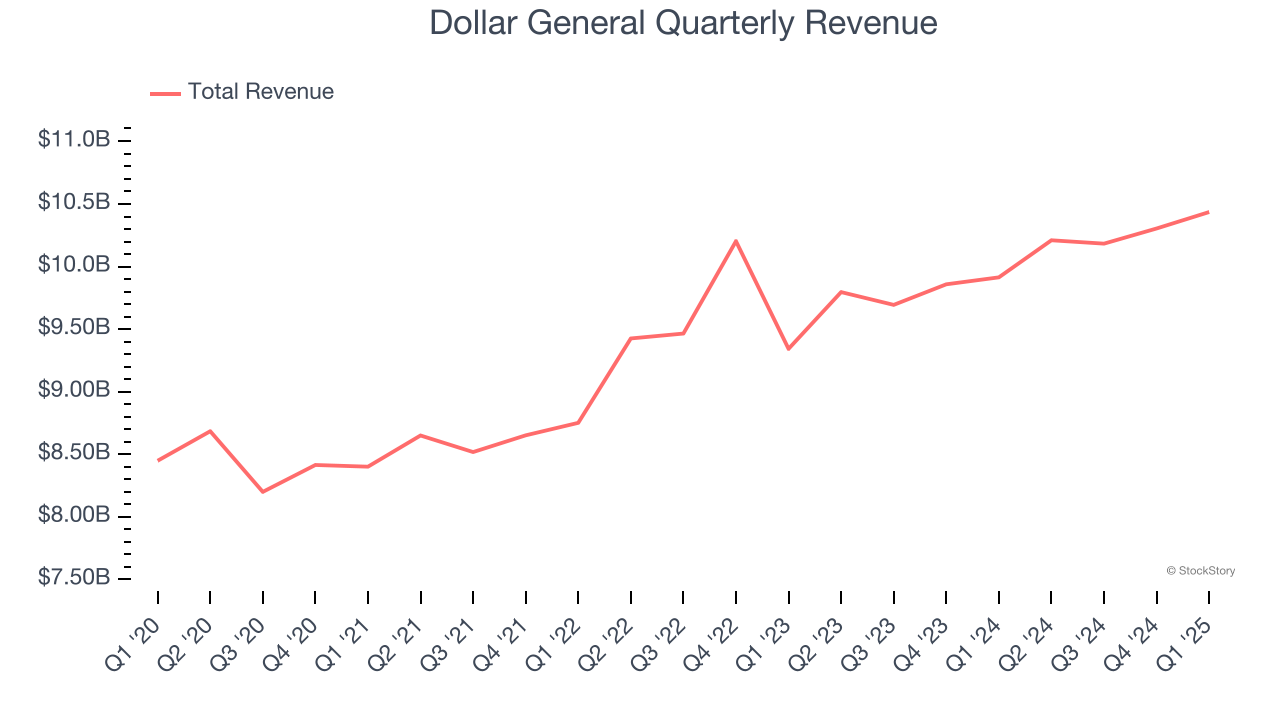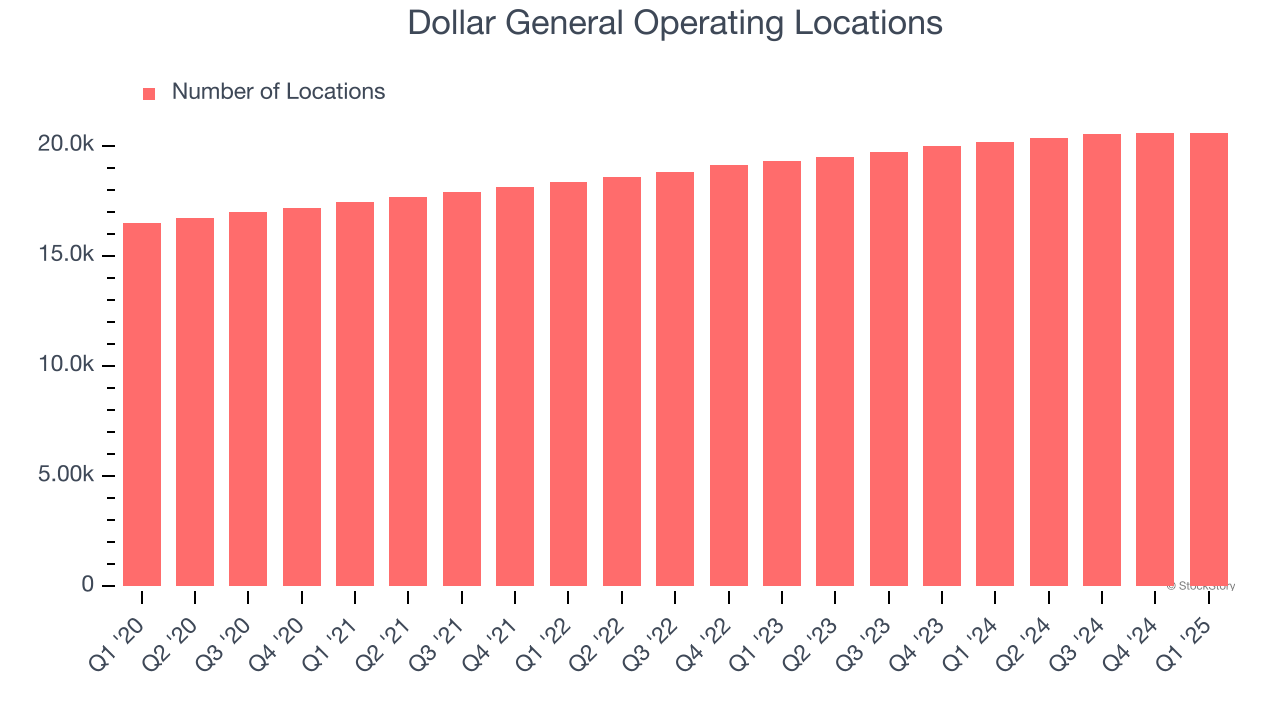
Discount retailer Dollar General (NYSE: DG) beat Wall Street’s revenue expectations in Q1 CY2025, with sales up 5.3% year on year to $10.44 billion. Its GAAP profit of $1.78 per share was 19.5% above analysts’ consensus estimates.
Is now the time to buy Dollar General? Find out by accessing our full research report, it’s free.
Dollar General (DG) Q1 CY2025 Highlights:
- Revenue: $10.44 billion vs analyst estimates of $10.26 billion (5.3% year-on-year growth, 1.7% beat)
- EPS (GAAP): $1.78 vs analyst estimates of $1.49 (19.5% beat)
- Adjusted EBITDA: $859.2 million vs analyst estimates of $756.3 million (8.2% margin, 13.6% beat)
- EPS (GAAP) guidance for the full year is $5.50 at the midpoint, missing analyst estimates by 1.8%
- Operating Margin: 5.5%, in line with the same quarter last year
- Free Cash Flow Margin: 5.3%, up from 3.2% in the same quarter last year
- Locations: 20,582 at quarter end, up from 20,149 in the same quarter last year
- Same-Store Sales rose 2.4% year on year, in line with the same quarter last year
- Market Capitalization: $21.37 billion
“We are pleased with our start to the year, including strong same-store sales and EPS results,” said Todd Vasos, Dollar General’s CEO.
Company Overview
Appealing to the budget-conscious consumer, Dollar General (NYSE: DG) is a discount retailer that sells a wide range of household essentials, groceries, apparel/beauty products, and seasonal merchandise.
Sales Growth
A company’s long-term performance is an indicator of its overall quality. Any business can have short-term success, but a top-tier one grows for years.
With $41.13 billion in revenue over the past 12 months, Dollar General is one of the larger companies in the consumer retail industry and benefits from a well-known brand that influences purchasing decisions. However, its scale is a double-edged sword because there are only a finite number of places to build new stores, making it harder to find incremental growth. For Dollar General to boost its sales, it likely needs to adjust its prices or lean into foreign markets.
As you can see below, Dollar General’s sales grew at a mediocre 7.9% compounded annual growth rate over the last six years (we compare to 2019 to normalize for COVID-19 impacts).

This quarter, Dollar General reported year-on-year revenue growth of 5.3%, and its $10.44 billion of revenue exceeded Wall Street’s estimates by 1.7%.
Looking ahead, sell-side analysts expect revenue to grow 3.5% over the next 12 months, a deceleration versus the last six years. We still think its growth trajectory is satisfactory given its scale and suggests the market is baking in success for its products.
Today’s young investors won’t have read the timeless lessons in Gorilla Game: Picking Winners In High Technology because it was written more than 20 years ago when Microsoft and Apple were first establishing their supremacy. But if we apply the same principles, then enterprise software stocks leveraging their own generative AI capabilities may well be the Gorillas of the future. So, in that spirit, we are excited to present our Special Free Report on a profitable, fast-growing enterprise software stock that is already riding the automation wave and looking to catch the generative AI next.
Store Performance
Number of Stores
A retailer’s store count influences how much it can sell and how quickly revenue can grow.
Dollar General operated 20,582 locations in the latest quarter. It has opened new stores at a rapid clip over the last two years, averaging 4.1% annual growth, much faster than the broader consumer retail sector.
When a retailer opens new stores, it usually means it’s investing for growth because demand is greater than supply, especially in areas where consumers may not have a store within reasonable driving distance.

Same-Store Sales
A company's store base only paints one part of the picture. When demand is high, it makes sense to open more. But when demand is low, it’s prudent to close some locations and use the money in other ways. Same-store sales gives us insight into this topic because it measures organic growth for a retailer's e-commerce platform and brick-and-mortar shops that have existed for at least a year.
Dollar General’s demand within its existing locations has barely increased over the last two years as its same-store sales were flat. Dollar General should consider improving its foot traffic and efficiency before expanding its store base.

In the latest quarter, Dollar General’s same-store sales rose 2.4% year on year. This growth was an acceleration from its historical levels, which is always an encouraging sign.
Key Takeaways from Dollar General’s Q1 Results
We were impressed by how significantly Dollar General blew past analysts’ EPS and EBITDA expectations this quarter. We were also glad its revenue outperformed Wall Street’s estimates. On the other hand, its full-year EPS guidance missed. Still, we think this was a solid quarter with some key areas of upside. The stock traded up 7.3% to $104.20 immediately after reporting.
Indeed, Dollar General had a rock-solid quarterly earnings result, but is this stock a good investment here? What happened in the latest quarter matters, but not as much as longer-term business quality and valuation, when deciding whether to invest in this stock. We cover that in our actionable full research report which you can read here, it’s free.






